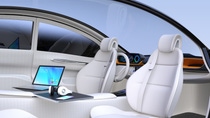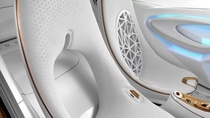Automotive
Reimagining autonomous interior design
Autonomous vehicles are anticipated to transform how we travel from point A to point B, and what we can do while in-transit.
Once there is no longer a need for a driver, the in-vehicle experience will change. Instead of operating the car, we will have more freedom to relax, do work or be entertained. Future vehicle interiors are envisioned to be a living room on the road.
As fully autonomous vehicles become more “fun to ride”, there will be a greater focus on the utility of the interior space, balancing design with functionality.
If you look back 40 to 50 years, you can see that the vehicle’s interior architecture has not really changed. However, this transition to autonomous driving is influencing how OEM designers and engineers conceptualize a new look and feel for the vehicle. The interior transformation will be more evolutionary than revolutionary, and BASF provides solutions that address mobility needs now and in a fully autonomous future.
Flexible seating configurations
One anticipated change to the architecture of autonomous interiors is the seating configuration. Fully autonomous vehicles will eliminate the designated driver’s chair. A specific seat arrangement or direction will no longer be necessary, freeing up cabin space. With more space, seats will be able to rotate or recline further instead of remaining in an upright position.

As the autonomous vehicle interior becomes an extension of a living room, passengers will expect a similar level of comfort. BASF’s Elastoflex W foam system can be used for seating applications to create a cushioning material with a soft feel and strong support even after prolonged use. In addition to contributing to seat comfort, Elastoflex is used as a noise, vibration and harshness (NVH) solution, reducing unwanted sound interference in the cabin. Passengers will be able to quietly read or watch a movie without being disturbed by engine noises or road bumps.
For luxury vehicles, automakers can incorporate synthetic leather made with Elastollan in car seats. Elastollan is abrasion resistant, with soft surface feel and high mechanical performance, making it an ideal solution for seating applications. This material also offers a range of color and design possibilities to create upscale, customized looks.
Repurposing dashboards and center consoles
Another interior architectural change will be reflected in the dashboard. Without a dominate seating arrangement, the dashboard will no longer be positioned at the front of a vehicle. Different components or electronics that are typically placed in the dashboard can be rearranged. Dashboard functions may be incorporated into seats, giving passengers direct access to the air conditioning or radio as they ride.

Similarly, the center console won’t be as prominent in self-driving vehicle interiors. Components typically placed in the center console will be re-positioned to the sides of vehicles rather than the front. As a result, door panels will take on the functionality of a center console. Door panels remain near passenger seats where speakers, cup holders and even pockets to hold cell phones could be incorporated into the side paneling.
Facing greater wear and tear, door panels will need to maintain high abrasion resistance and long-lasting durability. Elastoskin, BASF’s polyurethane skin technology, is resistant to weathering from factors like cleaning agents, UV light and fluctuating temperatures. It has good haptic properties, providing a pleasant, soft feel and luxurious appearance. Elastoskin is beneficial for areas like interior door paneling that must be resistant without sacrificing aesthetics. In addition to Elastoskin, BASF has a lightweight composite offering with CONTOURA™, a solution that combines its ACRODUR® resin with natural, recycled or synthetic fibers to produce a pre-preg composite. CONTOURA is well-suited for compression molding to create flat automotive parts such as door panels, underbody shields, roof components and instrument panels.
With the transition to fully autonomous vehicles, the amount of high quality and partially functionalized surfaces are anticipated to increase. High glossy and chemical resistant, Ultramid Deep Gloss is the ideal material for decorative trims, panels and inlays. Ultramid Deep Gloss enables designers to incorporate textures or shapes into interior surfaces for new, distinctive designs.
Heating autonomous interior surfaces
Just as living rooms have radiators or heated floors, passengers may also expect the autonomous vehicle interior to incorporate heated surfaces. Engineers will need to integrate new mechanisms that heat up the interior space to increase passenger comfort and remain energy efficient.
Materials used for these heating applications must be heat resistant and maintain high dimensional stability. BASF offers a portfolio of heat management solutions to help OEMs navigate the challenges of designing the next wave of vehicles.
New mobility will impact the riding experience. The look, feel and functionality of interior spaces will be transformed, especially as the vehicle takes over driving functions.

Consult with an expert
Self-service solutions: